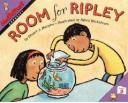So you’re wondering how in the world are you going to be able to teach your students about capacity and liquid measurement in a fun and easy way. Room for Ripley by Stuart J. Murphy & illustrated by Sylvie Wickstrom playfully & simply teaches readers how to measure cups, pints, quarts, half gallons, and gallons.
Carlos is getting a fish of his own – a lively guppy named Ripley. But first he has to make sure there’s enough water in Ripley’s new fish bowl. How much water will it take before there’s room for Ripley? Readers can count cups, pints, quarts, half gallons, and gallons as they learn about capacity and liquid measurement. Murphy (1999) writes, “Carlos added two more cups-another pint. Now there was a quart of water in the bowl”(pg. 14). Stuart J. Murphy and Sylvie Wickstrom’s story combines math and science with the fun of getting a new pet. There’s even a fun surprise for Carlos at the end- and one for Ripley too!
Curriculum Connections – The Virginia Science SOL’s for grades K-3 stresses the importance of posing simple questions in relation to measurement, and understanding both English and metric unit measurement. Room for Ripley is appropriate for multiple grade levels and could be used to directly address SOL’s K.1 f, K.1 g, and 2.1 e specifically.
If you would like to have more fun with the concepts presented in Room for Ripley, here are a few suggestions for grades K-3:
-
Read the story aloud with the students and talk about what is going on in each picture.
-
Ask questions throughout the story, such as: “How much water is in the tank now?” “Do you think that will be enough for Ripley, or will Carlos have to add more?” Which is more, a pint or a quart? Why?
-
Try the fish bowl example in your classroom: Bring in a large container & give the students measuring cups. Have the students estimate how many cups of water it will take to fill the container, and keep track of the cups as he or she fills the container with water. After the container is filled, help the students figure out the capacity of the container. Is it approximately a pint? a quart? a half gallon? a gallon?
-
Look in your kitchen and identify items like a milk, water, cottage cheese that come in different containers of different capacities. Bring these in to your classroom to show the differences in these units. Slowly introduce metric measurements as well by using other containers in your kitchen or local supermarket. For older children, use this as a way to begin a discussion about volume, mass, & length. This will also begin to address SOL’s 3.1 a, 3.1 d, 3.1 e, and 3.1 f.
Additional Resources -Try these websites where you’ll find lesson plans, worksheets, activities and coloring pages to aid your measurement education quest:
-
The Science Spot – metric mania lesson plans, worksheets, powerpoints, lab ideas, videos and more links to more cool metric websites!
-
EdHelper – oodles of measurement worksheets, puzzles, coloring pages – English & metric systems
-
Education World – lesson plans and worksheets plus links to other subjects
Book: Room for Ripley
Author: Stuart J. Murphy
Illustrator: Sylvie Wickstrom
Publisher: HarperCollins
Pulication Date: 1999
Pages: 40 pages
Grade Range: K-3
ISBN-13: 978-0064467247

